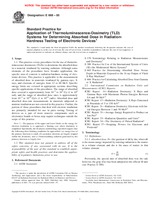We need your consent to use the individual data so that you can see information about your interests, among other things. Click "OK" to give your consent.
ASTM E668-00
Standard Practice for Application of Thermoluminescence-Dosimetry (TLD) Systems for Determining Absorbed Dose in Radiation-Hardness Testing of Electronic Devices
STANDARD published on 10.6.2000
The information about the standard:
Designation standards: ASTM E668-00
Note: WITHDRAWN
Publication date standards: 10.6.2000
SKU: NS-47591
The number of pages: 18
Approximate weight : 54 g (0.12 lbs)
Country: American technical standard
Category: Technical standards ASTM
Annotation of standard text ASTM E668-00 :
Keywords:
Absorbed radiation dose, Dosimetry, Electrical conductors-semiconductors, Electronic hardness, Electronic materials/applications, Electron radiation, Energy deposition-ionizing radiation, Gamma radiation-electronic components/devices, Hardness tests-radiation (of semiconductors), Radiation-hardness testing, Silicon semiconductors, Thermoluminescent dosimeter (TLD), Threshold detectors-60 MeV, X-irradiation, absorbed dose in radiation-hardness testing-electronic
Additional information
| 1. Scope | ||||||||
|
1.1 This practice covers procedures for the use of thermoluminescence dosimeters (TLDs) to determine the absorbed dose in a material irradiated by ionizing radiation. Although some elements of the procedures have broader application, the specific area of concern is radiation-hardness testing of electronic devices. This practice is applicable to the measurement of absorbed dose in materials irradiated by gamma rays, X rays, and electrons of energies from 12 to 60 MeV. Specific energy limits are covered in appropriate sections describing specific applications of the procedures. The range of absorbed dose covered is approximately from 10 -2 to 104 Gy (1 to 106 rad), and the range of absorbed dose rates is approximately from 10 -2 to 10 10 Gy/s (1 to 10 12 rad/s). Absorbed dose and absorbed dose-rate measurements in materials subjected to neutron irradiation are not covered in this practice. Further, the portion of these procedures that deal with electron irradiation are primarily intended for use in parts testing. Testing of devices as a part of more massive components such as electronics boards or boxes may require techniques outside the scope of this practice. Note 1-The purpose of the upper and lower limits on the energy for electron irradiation is to approach a limiting case where dosimetry is simplified. Specifically, the dosimetry methodology specified requires that the following three limiting conditions be approached: (a) energy loss of the primary electrons is small, (b) secondary electrons are largely stopped within the dosimeter, and (c) bremsstrahlung radiation generated by the primary electrons is largely lost.1.2 This standard does not purport to address all of the safety problems, if any, associated with its use. It is the responsibility of the user of this standard to establish appropriate safety and health practices and determine the applicability of regulatory limitations prior to use. |
||||||||
| 2. Referenced Documents | ||||||||
|
We recommend:
Updating of laws
Do you want to be sure about the validity of used regulations?
We offer you a solution so that you could use valid and updated legislative regulations.
Would you like to get more information? Look at this page.




 Cookies
Cookies
